|
Special Features





Image Libraries


|
|
Blog
If Maryland’s legislature fails to raise new transportation funding this year, the Purple Line light rail, Baltimore Red Line subway, and Corridor Cities Transitway BRT could all be cut or seriously delayed.
While reading a report about the Corridor Cities Transitway, I stumbled on these renderings of two of its more important stations. The first shows King Farm, near Shady Grove Metro, and the second shows Metropolitan Grove, a TOD in Gaithersburg where the CCT will meet an existing MARC station.
Note the relatively simple brick stop shelters, especially.

King Farm station.
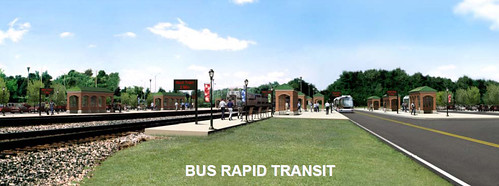
Metropolitan Grove station, showing MARC on the left.
Average Rating: 4.9 out of 5 based on 291 user reviews.
February 26th, 2013 | Permalink
Tags: architecture, BRT, funding, government, transportation

WashCycle reports today that the proposed 9th Street cycle track isn’t going to happen, because it is being removed from the regional long term plan. Fortunately, that’s incorrect.
I’ve spoken with DDOT about this, and they explain that the cycle track is still planned, and is simply being removed from the regional document because it doesn’t have to be listed there. The purpose of the regional plan is to model air pollution, and DDOT’s concept for the cycle track won’t impact the pollution computer model enough to bother with the added bureaucracy of keeping it in the plan.
Ironically, taking the cycle track out of the regional plan will actually make it easier to deliver, because it will reduce the number of bureaucratic hoops DDOT has to jump through in order to make the project happen.
Welcome to the confusing world of federal transportation reporting requirements!
Average Rating: 4.9 out of 5 based on 278 user reviews.
February 20th, 2013 | Permalink
Tags: bike, government, transportation

|

Photo by sbluerock on flickr. |
When is a moratorium, for liquor or otherwise, useful? When is it not?
Theoretically, local moratoriums on certain types of development can strengthen neighborhoods by encouraging a broader mix of uses. Unfortunately, they rarely actually work that way. More often, moratoriums are misused by opponents of growth in general, to try and slow or stop change.
As DC debates the possibility of a moratorium on liquor licenses on U Street, it’s worth discussing the issue more seriously than yesterday.
The basic truth of moratoriums is that they don’t usually stop things, but rather move them somewhere else. Banning bars on U Street doesn’t eliminate demand for bars, it simply pushes any new supply to the next best location. Residential moratoriums, which are sometimes used in fast growing suburbs, are the same.
So any discussion of a local ban on any particular use needs to consider where that use is most appropriate. It’s not enough to just say “I don’t want more of X in my neighborhood.” We have to plan where we do want that use, make sure it can happen there, and then plan what we want in the banned location instead.
Malls versus neighborhoods
One of the advantages suburban malls have over urban neighborhoods is total control of the merchant mix. Mall owners know that it’s important to have a wide variety of stores, so the best malls typically lease spaces to shops that will improve their mix, rather than those that will pay the highest rent.
When you’re at a mall and Verizon has a big luxurious shop, but AT&T and T-Mobile only have little carts, it isn’t because AT&T and T-Mobile can’t afford to outbid that shoe store down the hall; it’s because the mall owner will only lease out one big space to cell phone providers.
That isn’t limiting the free market. On the contrary, it’s taking a broad long term view of the market.
Urban neighborhoods usually can’t be as selective, because every building has a unique owner. Mall owners are concerned about the overall profit of the entire mall, so they can turn down high leases on individual storefronts if they think it will pay off with a little more business everywhere else. But if you only own one individual storefront, you’re going to maximize it with the highest paying tenant you can find.
That sometimes results in neighborhoods with a bad mix of stores. We certainly see that in DC, where many of our retail strips have a glut of bank branches, cell phone stores, and pharmacies.
So if used carefully, moratoriums can help level the playing field for urban neighborhoods with a lot of small land owners. If the neighborhood is desirable enough to fill all its storefronts regardless, and if the moratorium is thought of as more of a way to promote something new rather than limit something old.
But moratoriums shouldn’t be tossed around lightly. The key is to plan for what you do want and then make it happen. Moratoriums fail when they’re used without a master plan guiding them towards a specific goal.
And sometimes, it’s worth having a high ratio of certain things. For example, as a regionally-significant nightlife district, it’s acceptable for U Street to have a lot of bars.
 Cross-posted at Greater Greater Washington. Cross-posted at Greater Greater Washington.
Average Rating: 4.6 out of 5 based on 284 user reviews.
February 12th, 2013 | Permalink
Tags: government

|
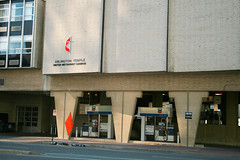
Photo by Joshua Davis. |
In response to Virginia Governor Bob McDonnell’s insane plan to fund transportation by eliminating the gas tax, Democrats in Virginia’s House of Delegates have proposed an alternative. It combines Democratic and Republican proposals to increase the gas tax statewide and give Northern Virginia separate authority to raise its own new funds.
Yesterday, the House Democratic Caucus outlined principles they believe should underlie any transportation funding plan for Virginia, and offered their support for a collection of 9 alternate bills which they say form a bipartisan path forward and an alternative to the governor’s plan.
Among those bills are Republican–written proposals to institute a new 5% fuel tax and to raise sales taxes in Northern Virginia specifically for transportation projects in that part of the state.
Any transportation plan, the House Democrats say, should:
- Generate at least $1 billion in new money per year.
- Rely on a realistic, dependable source of revenue, based on Virginia’s actions, not potential federal changes that may or may not happen.
- Not transfer monies that otherwise fund schools, health care, and public safety.
- Fund not just maintenance, but construction, including rail and transit.
- Provide additional revenue both immediately and into the future.
- Give authority to Northern Virginia and Hampton Roads to raise additional funds for their own transportation needs.
These are solid principles, and they offer a stark contrast to McDonnell’s plan. The governor’s proposal would raise far less, and relies on money from the general fund, as well as from a federal Internet sales tax that has not passed Congress.
The 9 specific bills that Democrats cited as true to those core principles are HB1677, HB1878, HB2063, HB2179, HB2253, HB2333, HB1450, HB1472, and HB1633. The House could pick one of those 9 to push, or it could try to amend one of them to combine the best provisions from all.
Republicans control the Virginia House, and the Senate is evenly split, so any plan will need GOP support to pass.
Although it’s true that some questionable highway projects would surely be built if Virginia ultimately adopts this transportation funding plan, this also offers far more support for transit and urban needs than the governor’s proposal, and it doesn’t include as many harmful, regressive policies. This is a far more reasonable outline.
 Cross-posted at Greater Greater Washington. Cross-posted at Greater Greater Washington.
Average Rating: 5 out of 5 based on 175 user reviews.
January 29th, 2013 | Permalink
Tags: funding, government, transportation

|
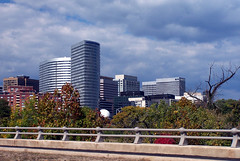
Rosslyn, once again eligible for DoD offices. |
On a day when Maryland released renderings of the Purple Line subway in Bethesda, and Arlington got specific on streetcar vehicles, the biggest urbanist news is probably that the Department of Defense has relaxed security rules that effectively outlawed using urban buildings for DoD offices.
After 9/11 the Pentagon established strict security standards for DoD offices. Among other things, those standards required large setbacks from the street, which meant that offices couldn’t locate in the most central urban areas, or in pedestrian-oriented buildings. This pushed a lot of federal workers out of Metro-accessible offices in places like Rosslyn and Crystal City out to more suburban locations.
The new rules, which were announced on December 7 but didn’t hit the public news until yesterday, relax the rules so that DoD offices only have to comply with the same design standards as federal office buildings leased by civilian agencies. This means they can once again locate in urban buildings.
Not only does this eliminate a major advantage that suburban office centers had over urban ones, it also reduces the pressure to build bad suburban buildings in urban places that should be walkable.
Good news.
Average Rating: 4.7 out of 5 based on 159 user reviews.
December 20th, 2012 | Permalink
Tags: government, lightrail, streetcar, transportation, urbandesign

In recent years there has been a lot of discussion about raising DC’s building height limit. Today that discussion moved into the realm of official policy-making, as Congress announced it will study the issue. Any change to the height limit would need Congressional sign-off.
In general I think the height limit should be raised subtly, in key places for key reasons, based on careful planning. I’m in favor of using taller buildings to incentivize more development where we want it, but don’t think it would be wise to simply eliminate the limit completely.
That’s sounds simple, but the issue is pretty complex. Here are some key points, with links to more expanded discussion:
- Uptowns: Raising the limit in places like Anacostia and Tenleytown would encourage them to develop as uptowns, like Arlington and Bethesda.
- Negatives: Raising the limit in downtown DC would increase pressure to tear down historic buildings, and decrease the pressure to fill in parking lots and other underused properties.
- Tall =/= dense: Counterintuitively, midrise development is often more dense than skyscrapers.
- Residential bonus: Giving developers a height bonus in exchange for building apartments instead of office would increase the vitality of downtown.
- Do it, but carefully: We should raise the height limit with a scalpel, not a hatchet.
- Trade-offs: Despite economic advantages, there are non-economic trade-offs about raising the height limit that we can’t ignore.
- Be practical:: We should consider how to realistically improve the city’s regulations, not stake out dogmatic extremes.
Average Rating: 4.8 out of 5 based on 253 user reviews.
November 8th, 2012 | Permalink
Tags: government, land use, master planning, preservation, urbandesign

Rockville and Gaithersburg are nearly identical in many ways, and usually get along. But they aren’t happy with each other right now, as they fight over who will annex a property located in the narrow swath of unincorporated land between them. This fight shows how long-term planning works and why it is important.
The crux of their disagreement is that Gaithersburg wants to annex a piece of land near the Rockville border that Rockville has never annexed itself, but to which Rockville thinks it is entitled. The land is south of Shady Grove Road, which many people think of as the unofficial boundary between the two cities.
But what people think of unofficially is not the law. There are actually laws on the books that govern how annexation works. When the dust settles, Gaithersburg is going to win this fight, because Gaithersburg has proactively thought about its long term planning needs, while Rockville has been strictly reactive.
The State of Maryland requires incorporated cities to adopt a future expansion plan, showing areas that each city may want to annex in the future. The entire point of this requirement is to give cities the opportunity to show where their “unofficial” boundaries are, so that everyone can plan accordingly.
And whether Rockville cares to admit it or not, they never made any kind of claim to the land in question until after Gaithersburg claimed it for itself, despite many opportunities to do so. If Rockville thought itself entitled to everything south of Shady Grove Road, then Rockville should have used the state’s process to stake a legal claim.
Here are maps showing each city’s adopted expansion plans, taken from their respective growth plans:

Rockville |
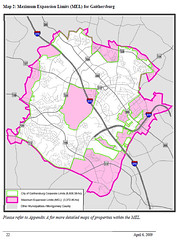
Gaithersburg |
The property in question is near the south-east corner of Shady Grove Road and Frederick Road (map).
The Gaithersburg plan was adopted in 2009, and clearly shows this property as part of Gaithersburg’s claim area. It’s possible Gaithersburg claimed the land even earlier, but at the very latest by 2009 they had declared their intention to the land. Meanwhile, Rockville’s plan shows that they didn’t start thinking about this property until 2010, and had even specifically excluded it from their expansion plan during their previous update in 2002.
If Rockville wanted this land, why didn’t they claim it in 2002? Or even before? If they really thought of Shady Grove Road as the boundary with Gaithersburg, why not make it official during any of the many updates to their expansion plan over the decades? Why wait until after Gaithersburg claimed it to express any interest?
Rockville didn’t plan for the long term, and Gaithersburg did, and so Gaithersburg is going to win. They are set to annex the property at tonight’s City Council meeting, and Rockville is powerless to stop it.
This is a good lesson to everyone. Proactively plan for what you want, or lose out to someone who did.
Average Rating: 4.4 out of 5 based on 260 user reviews.
August 6th, 2012 | Permalink
Tags: government, master planning

Besides the popular TIGER program, the US Department of Transportation has 12 other discretionary competitive grant programs. They’re all relatively small, generally awarding no more than a couple of million dollars to any given project. Yesterday USDOT announced its award winners for 2012, and the DC region hauled in a bunch of awards.
In total, the DC region got 13 grants totaling about $18.5 million. We won grants through 6 of the 12 programs, including multiple grants in two categories. Here’s the breakdown:
| Location |
Amount |
Description |
Public Lands Highway Discretionary Program
For any kind of transportation project within or providing access to federal lands or facilities. |
| DC |
$6, 042, 000 |
American Veterans Disabled for Life Memorial
This project will reconfigure a roadway, including utility work, signage, lighting, pavement markings and improved pedestrian facilities, to make possible the construction of the American Veterans Disabled for Life Memorial near the U.S. Capitol. |
| MD |
$2, 060, 000 |
Chesapeake & Delaware (C&D) Canal Recreational Trail
This project will complete the western 1.8 miles of the recreational trail linking Chesapeake with the Delaware River. The existing gravel service road on the north side of the C&D Canal will be transformed into a multi-purpose recreation trail with signage, operations and maintenance activities. |
| VA |
$496, 000 |
Design for Army Navy Drive Complete Street
This project will design upgrades for Army Navy Drive, the key arterial street between the Pentagon, I-395, and the Pentagon City / Crystal City transit-operations. Designed to funnel automobiles on and off I-395, the existing streets are extremely inhospitable to pedestrians, bicyclists, and transit users coming from or going to the Pentagon.
|
| VA |
$1, 000, 000 |
Route 1/Fuller Heights Road and Fuller Road Relocation
This project will realign and improve the intersection of Route 1 with Fuller Heights and Fuller Roads to create safe and secure access to the main gate of Marine Corps Base Quantico. |
Transportation, Community and System Preservation Program
Promote coordination among transportation, community, and system preservation. Funds to improve efficiency, reduce environmental impacts, and improve access to jobs, services, and centers of trade. |
| DC |
$1, 000, 000 |
Kennedy Street Revitalization
TCSP funds will help upgrade streetlights and sidewalks on Kennedy Street and improve safety at key intersections. |
| Regional |
$160, 000 |
High Impact Complete Streets Access Improvements for Rail Station Areas in the Washington Region
TCSP funds will be used to plan for improved bicycle and pedestrian access improvements near rail stations in the Washington, DC area to support housing and employment development. |
| MD |
$827, 200 |
Complete Streets Near Metro Stations
TCSP funds will help improve pedestrian safety with crosswalks on public roadways near the Twinbrook Metro station and provide space on South Stonestreet Avenue near the Rockville Metro station for bike lanes and a sidewalk. |
| MD |
$1, 000, 000 |
Maryland Route 5 at Brandywine Road and Maryland Route 373 Intersection Relocation Phases 2-3
TCSP funds will help acquire a portion of the right-of-way needed to widen about 4, 000 feet of road, replace existing signalized intersections at Brandywine Road and MD 373 with a new interchange, and provide a park-and-ride lot for commuters. |
| VA |
$800, 000 |
Walk to Downtown Vienna Initiative
TCSP funds will improve local pedestrian safety by constructing sidewalks on side streets in downtown Vienna and improve access from neighborhoods to local stores and merchants. |
Highways for LIFE Pilot Program
Uses innovative technologies and practices to more quickly construct safe and efficient highways and bridges with longer life spans. |
| VA |
$1, 320, 000 |
Staffordboro Blvd. Park and Ride Access in Stafford County
This project will use roller compacted concrete, which allows for immediate opening to traffic and is durable against heavy loads, in the construction of the Staffordboro Park and Ride Expansion project. |
National Scenic Byways Program
Funding supports projects that manage and protect these roads recognized as having outstanding scenic, historic, cultural, natural, recreational, and archaeological qualities. |
| MD |
$55, 120 |
Star Spangled Banner Byway Signage
This project will install a signage system along the Battle-of-Bladensburg portion of the Star-Spangled Banner National Historic Trail and Byway. |
Truck Parking Facilities Program
For improvements related to commercial motor vehicle parking. |
| MD |
$2, 623, 993 |
New Truck Parking Spaces in Howard County
This project will construct 40 new truck parking spaces at the southbound welcome center on I-95 in Howard County to address a severe shortage of commercial vehicle parking along this portion of the I-95 corridor. |
Value Pricing Pilot Program
Supports projects that manage congestion on roads via pricing strategies, including congestion tolling, mileage-based car insurance, parking pricing, and others. |
| DC |
$1, 090, 000 |
Multimodal, dynamic parking pricing in downtown Washington, DC
This project will implement dynamic pricing and a reservation system for commercial vehicle parking to manage metered curb-side spaces in the congested downtown business district and tourist areas. It will encourage freight travel at off-peak times and enable tour bus operators to find parking, as well as use parking revenues to support transit services. |
Average Rating: 4.9 out of 5 based on 161 user reviews.
August 3rd, 2012 | Permalink
Tags: funding, government, transportation

|
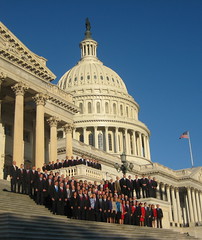
Image by Talk Radio News Service. |
Congress passed a major transportation bill last week, authorizing more than $100 billion in spending for highways, transit, and other modes over the next 2 years. The bill changes a number of rules and shifts the ways in which money is distributed, in an effort to preserve highway funding.
The bill generally maintains the status quo of federal transportation spending, but attempts to stretch the amount of money available for highways by eliminating or consolidating fringe programs, and shifting money from grants to loans.
$54.6 billion will be available per year, for the next 2 years. About 80% of funding will go to highways, and about 20% will go to transit. Both the overall funding level and the 80/20 split are comparable to existing allocations.
The gas tax will remain at 18.3¢ per gallon, as it has since 1993 when gas was $1.07. Since this won’t produce enough revenue to maintain current spending, almost $20 billion in federal general fund money will be infused in to the transportation fund.
Highways
As in every previous federal transportation authorization, the bulk of spending authority goes to highways. Most of the money will be automatically distributed to state Departments of Transportation, which will have the authority to determine spending on roads within their borders.
Little about this system will change, except that a little bit more money is available for highways due to cuts to other modes.
One thing that may change relating to highways is the make-up of the fleet of cars and trucks using them. This bill eliminates the so-called “gas guzzler tax, ” which raised a small amount of money but was a disincentive towards buying the least efficient cars and SUVs.
Another change is that more funding, up to $1 billion per year, is being directed to the TIFIA program, which offers loans to states and localities for major capital projects, instead of direct grants. TIFIA loan details are more favorable than private market deals, so this is a good option for large projects that don’t get grants. Meanwhile, by expanding a program that requires participants to pay it back, the feds stretch limited dollars further.
Transit
At one stage of negotiations, Republicans in Congress sought to eliminate transit funding altogether. That would have been a disaster. Thankfully it didn’t happen.
Much of the transit money flows to transit providers through automatic formulas, similarly to how highway money flows to state DOTs. The largest pot of non-automatic money is in the New Starts program, which is the major federal source for money to build new rapid transit routes.
New Starts is funded at $1.9 billion per year, which is $50 million per year less than the existing allocation.
For that money, the list of project types that are eligible to receive New Starts grants has been broadened, to include more BRT projects, as well as projects that expand the core capacity of existing transit lines. Also, a special category has been established for “demonstration projects” that are primarily funded with local or private money, and only need a little federal funding.
New Starts is extremely important. Virginia received $900 million from it to help build the Silver Line, and Maryland is counting on it to help fund the Purple Line, Corridor Cities Transitway, and Baltimore Red Line. Expanding the list of eligible uses is good, but it further spreads out an already diminished pot of money.
The competition for New Starts grants will be fierce, and the supply definitely won’t meet the demand.
Another change from previous law is that tax-exempt benefits for transit riders will continue to be capped at $125/month, while car drivers will continue to be eligible for corresponding parking benefits of up to $240/month. This is a blatant subsidy for driving over transit use, and is extremely unfortunate.
Some positive news is that there are two new transit programs established in the bill.
The first is a safety program that will institute nationwide safety standards for railcars, and require large transit agencies to establish safety plans. This is a direct outgrowth of WMATA’s problems in recent years, especially the June 2009 Metrorail crash.
The second new program will offer planning grants to help communities plan and build Transit Oriented Developments around transit stations, which is a nice win for smart growth.
Bike/ped
Bicycle and pedestrian funding was a major target for attack, and a major point of contention. Many rural and conservative congresspeople don’t understand the importance of these modes to urban transportation, and view them as unnecessary luxuries.
At several points throughout the negotiation process, it looked like dedicated bike/ped funding might be eliminated entirely. With the final adopted bill, it was reduced from about $1 billion annually to about $700 million annually. That’s too bad, but the fact that any survived at all is good news.
Of that $700 million, half will be distributed via automatic formula to Metropolitan Planning Organizations (MPOs) for use on bike/ped projects. Previously all of this money had been distributed to states, so sending it to metropolitan areas is an interesting change, and could be seen as an experiment in funneling money directly to metropolitan areas instead of through states.
Unfortunately, the other half of the $700 million in bike/ped money will go to state DOTs, who will have the option of either using it for bike/ped projects, or of flipping it in to their highway funds and using it for road projects. If all the states do this, it will decrease the total amount of federal bike/ped funding to just $350 million.
Although it is not strictly a dedicated bike/ped fund, another pot of money that is often used for bike/ped projects is the Congestion Mitigation and Air Quality program (CMAQ). Capital Bikeshare has largely been funded via CMAQ, so it is a significant program.
The good news is that CMAQ funding levels appear to be level. The bad news is that the list of eligible project types that can use CMAQ funds has been broadened to include a larger variety of road projects.
Environmental issues
Republicans in Congress had wanted to include in the bill funding for the Keystone Pipeline, which would have transported crude oil from Canada to refineries in the US. Democrats opposed it, and the fight was one of the most widely-reported sticking points in the negotiations.
Funding for the pipeline was not included, which was the major Republican concession agreed upon, in response to Democrat concessions regarding bike/ped and transit funding.
However, another aspect of the bill may have even more important and widespread effects.
A rarely-reported provision aimed at streamlining project delivery will eliminate the requirement for federal environmental review for a wide range of projects, including those within existing right-of-way, those that are below certain cost thresholds, and those that replace damaged infrastructure.
Excluding those projects will undoubtedly save millions of dollars, and months or even years of project planning. But it will also eliminate a key step in project review, and reduce the ability of localities to object to undesirable projects imposed on them by states. It is definitely a mixed blessing situation.
Summary
Just about everyone in the transportation policy world agrees that the current federal funding system isn’t working. Costs keep rising, and with the gas tax flat, spending power keeps dropping. Unfortunately, not everyone agrees about what to do.
Some want to find more sustainable revenue sources, and use them to build multimodal 21st Century infrastructure. Others want to eliminate multimodal programs and focus on spending limited money on what they see as the most important priority, highways.
This bill is a compromise. It puts off the larger questions of our country’s long term needs, and takes a slight regressive lean, in order to continue for 2 more years the overall status quo of an 18.3¢ tax going to an 80/20 highway/transit split.
 Cross-posted at Greater Greater Washington. Cross-posted at Greater Greater Washington.
Average Rating: 4.9 out of 5 based on 182 user reviews.
July 3rd, 2012 | Permalink
Tags: bike, BRT, bus, government, lightrail, metrorail, roads/cars, transportation

USDOT announced this morning about $500 million in multimodal “TIGER” grants in 47 locations around the US. A combined DC/MD/VA regional application that would have funded $20 million worth of bike/ped projects near Metro stations, as well as bikesharing expansions in Montgomery and Arlington, was not funded. However, DC and MD worked together on one that was.
The winning application received $10 million in federal funds to help pay for a 4-mile extension of the Anacostia Riverwalk Trail. The project will extend the trail along the east shore of the river, from Benning Road NE, through Kenilworth Gardens, to just shy of Bladensburg Road in Prince George’s County. It will include 5 bridge segments, and some raised sections.
This map shows the portion of the riverwalk that is being funded by TIGER. The pink dashed line in upper-right is the project.

TIGER funding is for the pink dashed line section in upper-right.
|

Location of Jefferson Co. West Virginia. |
AnacostiaWaterfront.org has a press release with additional information.
Jefferson County, WV is also a winner
The TIGER grant process stipulated that some percentage of winners had to be in rural areas. One of those rural awards went to Jefferson County, WV, which is the next county west from Loudoun, and is only about 60 miles from DC. They received $5 million in federal funds to help pay for a $24 million project to convert Fairfax Boulevard through the town of Ranson into a complete street, extend Fairfax Boulevard to a retail area on the edge of town, and build a transit center in downtown Charles Town that when complete will be the transfer location for bus service to nearby MARC stations in Harper’s Ferry, WV and Brunswick, MD.
The Town of Ranson’s project fact sheet gives additional details, and I created a map showing the location of the projects.
Average Rating: 5 out of 5 based on 276 user reviews.
June 22nd, 2012 | Permalink
Tags: bike, government, transportation

|
Media





Site
About BeyondDC
Archive 2003-06
Contact
Category Tags:
Partners
|

























